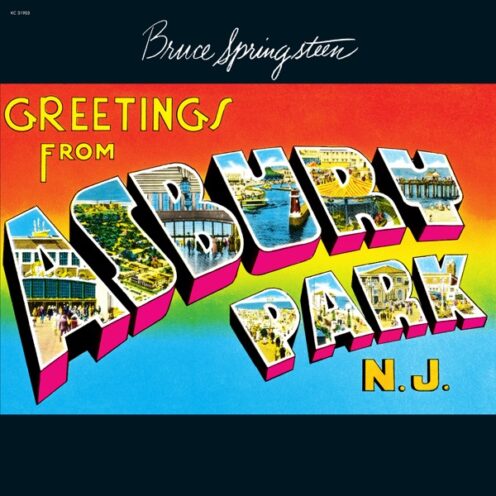
Greetings From Asbury Park, N.J. is one of the two records that Bruce Springsteen released before he was Bruce Springsteen. At this point in his career, a 23-year-old Springsteen was not yet The Boss, but a singer/songwriter who Columbia Records signed with the hope that he would blossom into the next Bob Dylan. To say the least, Columbia was not pleased with Springsteen’s January 1973 debut full-length, as Greetings had no huge singles and proved to be much more rock’n’roll than Columbia had bargained for.
The record was received well by critics at the time of release, but Springsteen didn’t become America’s favorite rock star right away. Columbia released “Blinded By the Light” and “Spirit In the Night” as singles, but neither had any impact whatsoever on any charts. Most people only know “Blinded By the Light” because of the remake by Manfred Mann’s Earth Band, and “Spirit By the Night” didn’t have the instant accessibility needed to become a regular number played on the radio. Considering the conditions under which the record was written, with Springsteen recording with producer/manager Mike Appel in one of the cheapest available studios in New York, it’s not much of a surprise that it only sold around 25,000 copies in its first year.
Despite the fact that Columbia wasn’t all that pleased with Springsteen’s first output, Greetings was an essential step in his career and did spawn a number of excellent songs. The entire record is nine tracks, with five of them going on to become notable fan favorites, especially at live shows. Both of the aforementioned singles are excellent to see live, and “Lost in the Flood” and “For You” both have legendary recorded performances. The interesting thing is that on Greetings, “Lost in the Flood” lacks most of the punch it packs at a live show. The same can be said to a lesser extent with “For You,” but that track is where I’d recommend a listener to start with Greetings.
”Blinded By the Light,” the opening track, is probably the most instantly accessible one. It’s easy to see why Columbia chose it as a single out of the bunch, but sitting at just over five minutes, it was going to be tough to see any significant radio play. The song is one of Springsteen’s catchiest, however, and it kicks off a remarkable first side of the record. “Growin’ Up” and “Does This Bus Stop At 82nd Street?” are both criminally underrated, even by the droves of Springsteen faithful. The only song that really could have been left off is probably “The Angel” – something that Springsteen himself might not even deny. The band has only played that song once live, at the first and only performance of Greetings in its entirety.
To keep it short and sweet, Greetings From Asbury Park, N.J. is not a Springsteen record I would throw at an unfamiliar listener. I have gone through phases where I listened to this record endlessly, where I thought it was one of The Boss’ better outputs. But in the end, Greetings is much more important for the chain of events it set off than for what it actually is as a record. If Columbia didn’t start pressuring Springsteen for something different, he may not have eventually written Born To Run.
Greetings also inspired an immensely important characteristic of Springsteen’s early following: the record became adored in pockets around the country, big markets that would flock to see him perform live. Springsteen performances became legendary even when he was only playing songs off Greetings and a few covers. He would turn a handful of original songs and crowd-pleasing covers into a performance that lasted two hours, and he quickly became enshrined as a working-class hero among Americans, even when his music was still making its way around the country in a more “underground” fashion. For a 23-year-old who learned the guitar by listening to the radio and figuring out top 40 hits in minutes, Greetings wasn’t a bad first crack at this whole record-making business.
Notable Fact: Ranked No. 379 on Rolling Stone magazine’s list of the best 500 albums of all time.
 Blinded by the Light
Blinded by the Light